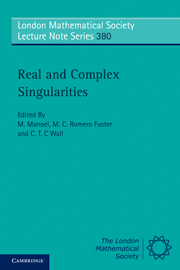Book contents
- Frontmatter
- Contents
- Preface
- 1 On a conjecture by A. Durfee
- 2 On normal embedding of complex algebraic surfaces
- 3 Local Euler obstruction, old and new, II
- 4 Branching of periodic orbits in reversible Hamiltonian systems
- 5 Topological invariance of the index of a binary differential equation
- 6 About the existence of Milnor fibrations
- 7 Counting hypersurfaces invariant by one-dimensional complex foliations
- 8 A note on topological contact equivalence
- 9 Bi-Lipschitz equivalence, integral closure and invariants
- 10 Solutions to PDEs and stratification conditions
- 11 Real integral closure and Milnor fibrations
- 12 Surfaces around closed principal curvature lines, an inverse problem
- 13 Euler characteristics and a typical values
- 14 Answer to a question of Zariski
- 15 Projections of timelike surfaces in the de Sitter space
- 16 Spacelike submanifolds of codimension at most two in de Sitter space
- 17 The geometry of Hopf and saddle-node bifurcations for waves of Hodgkin-Huxley type
- 18 Global classifications and graphs
- 19 Real analytic Milnor fibrations and a strong Łojasiewicz inequality
- 20 An estimate of the degree of ℒ-determinacy by the degree of A-determinacy for curve germs
- 21 Regularity of the transverse intersection of two regular stratifications
- 22 Pairs of foliations on surfaces
- 23 Bi-Lipschitz equisingularity
- 24 Gaffney's work on equisingularity
- 25 Singularities in algebraic data acquisition
18 - Global classifications and graphs
Published online by Cambridge University Press: 07 September 2011
- Frontmatter
- Contents
- Preface
- 1 On a conjecture by A. Durfee
- 2 On normal embedding of complex algebraic surfaces
- 3 Local Euler obstruction, old and new, II
- 4 Branching of periodic orbits in reversible Hamiltonian systems
- 5 Topological invariance of the index of a binary differential equation
- 6 About the existence of Milnor fibrations
- 7 Counting hypersurfaces invariant by one-dimensional complex foliations
- 8 A note on topological contact equivalence
- 9 Bi-Lipschitz equivalence, integral closure and invariants
- 10 Solutions to PDEs and stratification conditions
- 11 Real integral closure and Milnor fibrations
- 12 Surfaces around closed principal curvature lines, an inverse problem
- 13 Euler characteristics and a typical values
- 14 Answer to a question of Zariski
- 15 Projections of timelike surfaces in the de Sitter space
- 16 Spacelike submanifolds of codimension at most two in de Sitter space
- 17 The geometry of Hopf and saddle-node bifurcations for waves of Hodgkin-Huxley type
- 18 Global classifications and graphs
- 19 Real analytic Milnor fibrations and a strong Łojasiewicz inequality
- 20 An estimate of the degree of ℒ-determinacy by the degree of A-determinacy for curve germs
- 21 Regularity of the transverse intersection of two regular stratifications
- 22 Pairs of foliations on surfaces
- 23 Bi-Lipschitz equisingularity
- 24 Gaffney's work on equisingularity
- 25 Singularities in algebraic data acquisition
Summary
Abstract
We review some of the problems where the graphs have been applied to the study of the global classification of stable maps.
AMS Classification: 57R45, 57M15, 57R65
Key words: Stable maps; foliations; graphs; global classification
Introduction
Let M and N be manifolds, M compact and f : M → N. Assume that f defines an extra structure on any neighborhood of a point p ∈ M. The point p is said to be regular with respect to the extra structure if there exists a neighborhood Up of p such that for any q ∈ U there exists also a neighborhood Uq so that the extra structure is equivalent on the two neighborhoods. The study of the structure on Up leads to a local problem. The study of the decomposition of M in maximal subsets with an homogeneous structure leads to a global problem. One way to achieve the global problem is to associate a graph to this decomposition.
This method has been applied to the study of the global classification of flows and maps. The approach in each case goes as follows: Once the local and multi-local behaviour of the critical set has been described, the relevant global topological information is codified in a graph, possibly with labels in either the vertices, the edges, or both. The typical questions then are:
Determine all the (labelled) abstract graphs that can be associated to some of the objects under study (Realization Problem).
[…]
- Type
- Chapter
- Information
- Real and Complex Singularities , pp. 246 - 267Publisher: Cambridge University PressPrint publication year: 2010
- 1
- Cited by

